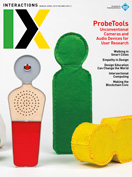Authors:
Ai-Hsuan Chou
Describe what you made. Rain Season is made up of three pieces. The Dynamics of Rain is inspired by flower petals swinging in the rain. I imagined that the petals become intoxicated when moistened by rain. The rain takes the swinging flower petals as a sign of welcome. The shape of the device was inspired by slender blooming flower stalks. The structure is made from laser-cut acrylic. Inside the device, there is a water-level sensor module, an Arduino Uno, and six servo motors. When it senses water, the motors are activated, causing the string-connected disk to vibrate.
For the Appearance of Rain, I was inspired by the reflections of the sky in little puddles on asphalt roads and the glimmer of neon lights reflected in dirty water on sidewalk tiles. The kaleidoscopic appearance of puddles seems to attract rain, drawing it down to earth. To showcase the many faces of water, I cut acrylic mirrors into different sizes and shapes and placed them around the city, hoping they would appeal to the vacillating raindrops in the sky above.
The Sound of Rain is equipped with a mini speaker, a water sensor, and an Arduino Uno board. When the device senses rain, a melody will slowly fade in and blend into the surroundings. The audio material is based on the sound of rain hitting different materials.
 |
Testing the 3D-printed joint that connects the pad and the stalk of the Dynamics of Rain. |
 |
To facilitate hiding the electronics under the tiles, testing if the water sensor could detect water through wires connected to the sensor. |
 |
Adjusting the length of the strings to make the device move more flexible after some testing. |
What for you is the most important/interesting thing about what you made?
I was always inspired by the sound of raindrops hitting rooftops—it sounds so boisterous and diverse. I used to imagine the raindrops were fascinated by the sound too, and thus chose to come down and sing together. Because raindrops produce different sounds when they hit different surfaces, the song of rain is always unique and varied.
 |
Testing how the devices work when connecting the strings to the servos and the disks. |
 |
The structure of the Dynamics of Rain. |
 |
The electronics of the Sound of Rain. |
To improve my understanding, I observed the journey of raindrops. I got inspired by how they hit tin roofs, flourishing gardens, and bumpy asphalt roads. For me, these three places highlighted the sound, dynamics, and shape of rain, so I made an object for each of them.
Was this a collaborative process, and if so, who was involved? To arrange the melody for the Sound of Rain, I invited Lydia Chiang, a friend with a deep musical background, to give me professional advice: "After I heard the sounds Chou had recorded on rainy days, I suggested that she not use the raw material, but instead make a mixture of sounds in computer software. To mimic the sounds of rain, I used different percussion instruments such as marimba and drums. The song is based on a repeated melody, strengthened by adding different instruments and rhythms seriatim, for rains always start by drizzling before turning heavy and fading away."
 |
The Sound of Rain |
 |
The Dynamics of Rain |
 |
The Appearance of Rain |
Ai-Hsuan Chou, Shih-Chien University
[email protected]
https://nino950437.wixsite.com/mysite-2/manufacturing
Copyright held by author
The Digital Library is published by the Association for Computing Machinery. Copyright © 2019 ACM, Inc.








Post Comment
No Comments Found